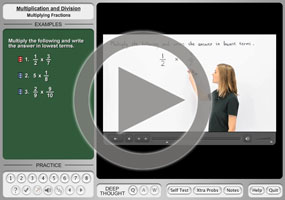Multiplying and Dividing Fractions
Purplemath
How do you multiply fractions?
Multiplying fractions is easy: you multiply the top numbers (that is, the numerators) and multiply the bottom numbers (that is, the denominators). If possible, you simplify things a bit.
Content Continues Below
For instance:
When it's possible, you reduce the fraction by cancelling off common factors; that is, you cross out any factors from one side of the fraction line that are duplicated on the other side of the line. In the example above, however, nothing reduces, because 8 and 45 have no factors in common.
If you're not sure whether anything can be cancelled off, you can always factor the numerator and denominator, and check for any duplicated factors:
Nothing is duplicated between the top and the bottom, so nothing cancels.
Often, though, something will cancel:
-
Simplify
Affiliate
To do this multiplication, I will multiply all the top numbers (that is, all the numerators) with each other, and multiply all the bottom numbers (that is, all the denominators) with each other.
However, to make life a little easier for myself, I'll first cancel off any factors that are common to both the numerators and the denominators:
Then the simplified product is .
You don't have to factor everything completely, of course. You can use shorthand to get the same answer:
...which leaves me with , as before.
You can use the Mathway widget below to practice multiplying fractions. Try the entered exercise, type in your own exercise. Then click the button to compare your answer to Mathway's. (Or skip the widget and continue with the lesson.)
Please accept "preferences" cookies in order to enable this widget.
(Clicking on "Tap to view steps" on the widget's answer screen will take you to the Mathway site for a paid upgrade.)
Content Continues Below
How do you divide by a fraction?
Dividing fractions is just about as easy as multiplying them; there's just one extra step. When you divide by a fraction, the first thing you do is "flip-n-multiply". That is, you take the second fraction, flip it upside-down (that is, you "find the reciprocal"), and then you multiply the first fraction by this flipped fraction.
-
Simplify
My first step will be to convert this to multiplication by flipping the to get . Then I can proceed with the simple multiplication, cancelling off any factors that are duplicated:
Then my simplified answer is .
(Why does flip-n-multiply work?)
-
Simplify
Affiliate
Advertisement
This one is a bit tricky, but I can deal with the whole-number 5 by converting it into a fraction. Remember that any whole number is a fraction, if you put it over "1". So I convert the 5 into the fraction , and flip-n-multiply:
Then my simplified answer is .
-
Simplify
For this exercise, I'll first have to convert the mixed numbers to (improper) fractional form. (Multiplying and dividing fractions are places where fractions are sooooo much nicer than mixed numbers!) Once I've got fractions, then I can flip-n-multiply.
Then my mixed-number answer is .
Note: When the inputs are mixed numbers, as in the last example above, the book (or your instructor, or the grader) usually expects a mixed number as the output, too. So, if your answer is an improper fraction, you'll need to convert it back to mixed-number form. Don't forget this step!
You can use the Mathway widget below to practice dividing fractions. Try the entered exercise, or type in your own exercise. Then click the button to compare your answer to Mathway's. (Or skip the widget and continue with the lesson.)
Please accept "preferences" cookies in order to enable this widget.
(Clicking on "Tap to view steps" on the widget's answer screen will take you to the Mathway site for a paid upgrade.)
Next, we move on to the much-more-difficult addition and subtraction of fractions...
URL: https://www.purplemath.com/modules/fraction3.htm
Select a Course Below
Standardized Test Prep
Homeschool Math
© 2024 Purplemath, Inc. All right reserved. Web Design by ![]()



